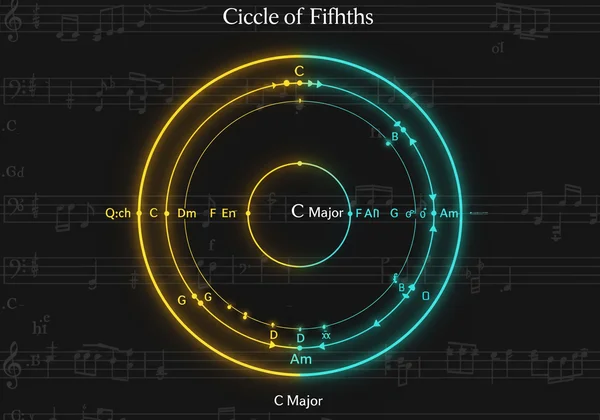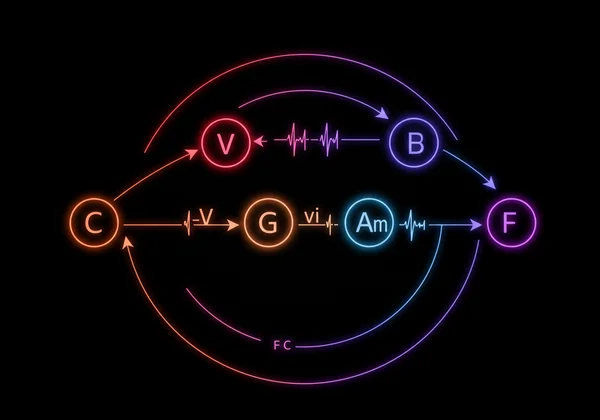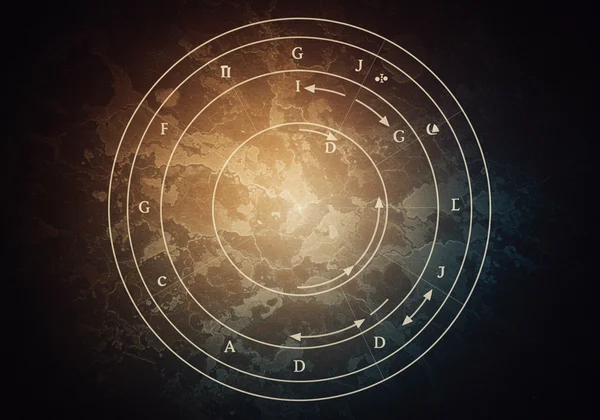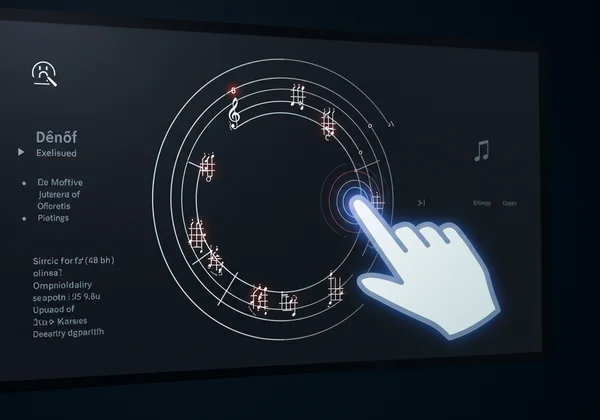Let It Be Chords: Circle of Fifths Song Analysis
The opening piano chords of "Let It Be" are instantly recognizable, a musical balm that has soothed listeners for decades. But what makes this simple-sounding song so powerful and emotionally resonant? The answer lies hidden in plain sight within its elegant structure, a structure perfectly revealed by the circle of fifths. If you’ve ever wondered how to use the circle of fifths to unlock the secrets of your favorite songs, you’ve come to the right place.
The Beatles, and Paul McCartney in particular, had an intuitive genius for melody and harmony. While they weren't formally trained in music theory, their compositions are masterclasses in how to create powerful emotional journeys through chords. By analyzing "Let It Be," we can transform the circle of fifths from an abstract diagram into a practical map for understanding and creating music. Let's dive in and see how this timeless tool illuminates a timeless classic. You can follow along by using our interactive music theory tool to see these concepts come to life.
Unpacking 'Let It Be': Key Signatures & Diatonic Chords
Before we map the song's journey, we first need to establish our "home base." The vast majority of "Let It Be" is firmly planted in the key of C Major. A key signature tells us which notes form the foundation of a song, creating a sense of resolution and stability. The key of C Major is the simplest of all, containing no sharps or flats.
When you select C Major on an interactive circle of fifths, you instantly see the family of chords that naturally belong to it. These are called diatonic chords—the building blocks that sound inherently "correct" together. Understanding this family of chords is the first step in decoding why the song's progressions feel so natural and satisfying.

Identifying the Core Keys: C Major and G Major in 'Let It Be'
The verse and chorus of "Let It Be" revolve around a core set of chords derived from C Major. This is the song's primary tonal center. The progression feels grounded and resolved every time it returns to the C chord. Think of C Major as the central point from which all the musical phrases begin and to which they ultimately return.
However, the song does briefly hint at another key. The G Major chord (the V, or dominant, of C) plays a crucial role in creating tension and release. In some sections, it feels so strong that it almost becomes a temporary key center itself. This movement between a key and its dominant is a fundamental concept in Western music, and the circle of fifths visualizes this powerful relationship perfectly.
The Diatonic Landscape: Exploring Chords within the Song's Keys
In the key of C Major, the primary diatonic chords are C (I), Dm (ii), Em (iii), F (IV), G (V), and Am (vi). Notice how "Let It Be" almost exclusively uses these chords in its iconic verse progression: C (I) - G (V) - Am (vi) - F (IV). This isn't a coincidence; it's the foundation of countless pop, rock, and folk hits.
By using these related chords, McCartney creates a progression that feels both familiar and emotionally compelling. The movement from C to G provides forward momentum, the shift to Am adds a touch of melancholy, and the arrival at F offers a sense of hopeful suspension before resolving back to C. Our online Circle of Fifths instantly displays all these diatonic chords for any key you select, taking the guesswork out of your analysis.
The Circle of Fifths in Action: Analyzing 'Let It Be's' Progressions
Now for the magic. How does the circle of fifths help us visualize these chord progressions? The circle is arranged so that keys and chords most closely related to each other are neighbors. The strongest harmonic relationship is between a chord and the chord a perfect fifth away—the one sitting right next to it on the circle.
Look at the circle. Find C. Its neighbor in the clockwise direction is G. This I-V relationship (C to G) is the engine of Western music, creating a powerful pull back to the tonic. The progression in "Let It Be" starts with this exact movement, immediately establishing a strong harmonic direction. This is a core principle of good songwriting.
Iconic Chord Progressions: How 'Let It Be' Creates Its Flow
The main progression, I-V-vi-IV (C-G-Am-F), is a masterclass in harmonic storytelling. After the strong C-G move, it shifts to Am, the relative minor of C. This chord shares two notes with C Major, making the transition smooth yet emotionally nuanced. You can see this relative minor relationship clearly on the inner ring of the circle of fifths.
From Am (vi), the progression moves to F (IV). In music theory, the move from IV to I (F to C) is known as a plagal or "Amen" cadence, providing a gentle, less forceful resolution than the V-I cadence. This sequence—tension (V), melancholy (vi), hope (IV), and resolution (I)—is what gives "Let It Be" its profound sense of peaceful acceptance. This entire journey can be traced as a simple, connected pattern when you visualize key relationships on our tool.

Subtle Modulations: Adding Emotional Depth with Key Changes
While "Let It Be" is largely in C Major, it uses secondary dominants to add color and emotional weight. A secondary dominant is a chord that temporarily makes a non-tonic chord feel like the tonic. For instance, before moving to G, you might hear a D Major chord. D Major is the V of G, so it creates a stronger pull towards the G chord than the diatonic D minor would.
These subtle key changes are like momentary detours on a familiar road, adding interest without getting lost. The circle of fifths is the ultimate map for navigating these modulations. It shows you the V chord for any key, allowing you to anticipate and understand these sophisticated harmonic choices, turning a complex theory into a simple visual guide.

Beyond Analysis: Applying 'Let It Be's' Lessons to Your Music
Analyzing a song by The Beatles is more than an academic exercise; it’s a direct lesson from the masters of Beatles music theory. By understanding why these chords work so well together, you can start applying the same principles to your own playing, songwriting, or improvisation.
The goal isn't just to deconstruct, but to reconstruct. The circle of fifths isn't just for analysis; it's a creative tool. It can help you break out of a creative rut, find a new chord to follow your melody, or transpose a song into a key that better suits your voice. It empowers you to understand the language of music on a deeper level.
Paul McCartney's Harmonic Intuition: What We Learn from the Masters
What we see in "Let It Be" is Paul McCartney's incredible harmonic intuition. He understood, on a deep level, the emotional weight of moving from a tonic to a dominant, or from a major to its relative minor. He didn't need a chart to tell him that the I-V-vi-IV progression felt right; he felt it.
The circle of fifths allows the rest of us to access that same intuition. It codifies these powerful relationships, making them visible and understandable. By studying the choices made by master songwriters, we can internalize these patterns and develop our own intuitive sense of songwriting and harmony.
Use Our Interactive Tool to Analyze YOUR Favorite Songs
The real learning begins when you apply these concepts yourself. What's a song you've always loved? Pull up the chords and find its key. Now, use our interactive tool to see its diatonic chords. Are they all within the key? Does it use the I-V-vi-IV progression? Does it borrow chords from other keys?
This hands-on approach is the fastest way to master music theory. Instead of memorizing abstract rules, you're connecting them to the music you already know and love. Our free tool is designed to make this process intuitive and fun. Give it a try and start your own journey of musical discovery. You can explore the circle of fifths right now on our homepage.

Your Turn: Unlocking the Secrets in Every Song
"Let It Be" is more than just a beautiful song; it's a perfect case study in the power of simple, effective harmony. By viewing its structure through the lens of the circle of fifths, we transform abstract music theory into a tangible, practical tool. We see that the song's emotional depth comes from the masterful use of fundamental harmonic relationships—relationships that are beautifully laid out on the circle.
Now it's your turn. The same principles that govern this Beatles classic are present in nearly every piece of music you love. The circle of fifths is your key to unlocking them. We invite you to visit our interactive music theory tool and start exploring. Analyze your favorite songs, experiment with new chord progressions, and take control of your musical education. The secrets are waiting for you.
Frequently Asked Questions About Circle of Fifths Song Analysis
What is the Circle of Fifths primarily used for in music analysis?
In music analysis, the circle of fifths is primarily used to visualize the relationships between the 12 tones of the chromatic scale. It helps musicians quickly identify a song's key signature, find its related diatonic chords, understand chord progressions, and map out modulations or key changes. It's a comprehensive map of harmony.
How can I find the key of any song using the Circle of Fifths?
To find a song's key, first identify the main chords used. Look for the chord that the song seems to resolve to or feels most "at home" on—this is likely the tonic (the "I" chord). Then, see if the other primary chords fit into the diatonic family of that key. Using an interactive circle of fifths tool makes this easy; simply click on your suspected key and see if the song's chords appear in the generated list.
Are all the chords in 'Let It Be' diatonic, and how does the Circle explain this?
The vast majority of chords in "Let It Be" are diatonic to the key of C Major (C, G, Am, F). The circle of fifths explains this by showing these chords are all closely related and belong to the same "family." C is the tonic, G is its dominant (V), F is its subdominant (IV), and Am is its relative minor (vi). Their proximity on or relation to the circle is what makes them sound so cohesive.
Does The Beatles' music often feature advanced music theory concepts?
Yes, while they were known for their pop sensibilities, The Beatles' music is rich with sophisticated music theory concepts. They frequently used borrowed chords (taking chords from a parallel key), secondary dominants, and unconventional modulations to create unique harmonic colors. Analyzing their music with the circle of fifths is a fantastic way to learn both foundational and advanced theory in a practical context.